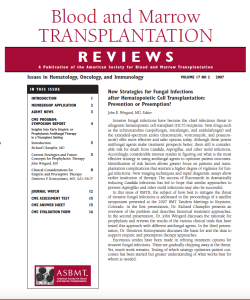 New Strategies for Fungal Infections after Hematopoietic Cell Transplantation: Prevention or Preemption?
New Strategies for Fungal Infections after Hematopoietic Cell Transplantation: Prevention or Preemption?
by John R. Wingard, Editor
Invasive fungal infections have become the chief infectious threat to allogeneic hematopoietic cell transplant (HCT) recipients. New drugs such as the echinocandins (caspofungin, micafungin, and anidulafungin) and the extended-spectrum azoles (itraconazole, voriconazole, and posaconazole) offer more effective and safer options today. Although these potent antifungal agents make treatment prospects better, there still is considerable risk for death from Candida, Aspergillus, and other mold infections. Accordingly, considerable interest resides in figuring out what is the most effective strategy in using antifungal agents to optimize patient outcomes. Identification of risk factors allows greater focus on patients and transplantation complications that warrant a higher degree of vigilance for fungal infections. New imaging techniques and rapid diagnostic assays allow earlier institution of therapy. The success of fluconazole in dramatically reducing Candida infections has led to hope that similar approaches to prevent Aspergillus and other mold infections may also be successful.
In this issue of BMTR, the subject of how best to mitigate the threat of invasive fungal infections is addressed in the proceedings of a satellite symposium presented at the 2007 BMT Tandem Meetings in Keystone, Colorado. In the first presentation, Dr. Richard Champlin presents an overview of the problem and describes historical treatment approaches. In the second presentation, Dr. John Wingard discusses the rationale for prophylaxis and reviews the results of the various clinical trials that have tested this approach with different antifungal agents. In the third presentation, Dr. Dimitrios Kontoyiannis discusses the basis for and the data to support empiric and preemptive therapy approaches.
Enormous strides have been made in refining treatment options for invasive fungal infections. These are gradually chipping away at the threat. Yet, much work remains. Testing of which strategy optimizes patient outcomes has been started but greater understanding of what works best for whom is needed.
Download a PDF version of the full issue.
